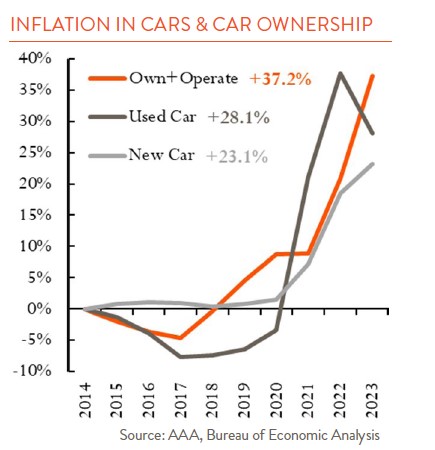
With the freshly minted 2024 edition of the Hanson Index (see page 2), inflation is on our minds. Surging used car prices got a lot of attention during the pandemic. While prices at the dealership have moderated, the all-in cost of car ownership has crept steadily higher (chart on right).
As it turns out, each year you drive now costs around $12,182 on average (for a $34,876 MSRP vehicle driven 15,000 miles/year). And you thought buying the car was the expensive part. How did we get here?
Every year, the American Automobile Association (AAA) sets out to measure the all-in cost of car ownership. AAA digs into insurance, maintenance, repairs, tires, gas, registration, taxes, depreciation, and the interest portion of financing. The big-ticket item is always depreciation, or the loss in the car’s value each year—and that matters if you plan on selling the car or trading it in for your next car. But if we focus just on the expenses that you have to shell out for, they’ve risen by over 30% since the start of the pandemic to around $7,600 per year. The biggest bumps have come from financing, insurance, and gas (see table at bottom).
Inflation in some of these items is straightforward, such as financing costs (car prices up, interest rates up a lot) and gas (tracks crude oil commodity prices),
but insurance is harder to decompose. Inflation has meant the cost of paying out claims is higher, but insurers also set premiums to account for the frequency and severity of accidents. A recent Wall Street Journal article reported that the severity of claims—for whatever reason—is up since the start of the pandemic. All of that has amounted to a pretty steep jump in auto insurance.
So owning and operating a car is much more expensive. What are we supposed to do about it? Public transit as a substitute is, unfortunately, not a reasonable option for much of the country. Of course, we can do the obvious thing, which is to drive less, since fuel, maintenance, and tire costs are all driven by mileage.
We could also pick a vehicle that is less expensive to own and operate. AAA’s report breaks down costs by vehicle type, and, unsurprisingly, small sedans are the least expensive overall. From there the costs work out about as you might expect, with the most expensive category being the half-ton pickup truck. Electric vehicles are the clear standout in operating costs per mile since electricity is generally cheaper than gas and maintenance costs are lower with no engine or related fluids.
A final point is to think about how you own a car. If you plan on driving the car until it stops working (i.e. it is “fully depreciated”), you might not care about the depreciation expense. There, again, electric vehicles are the standout, with relatively more of the cost of ownership coming from depreciation. All told, the least expensive car to own and operate, for a given purchase price, is going to be an electric vehicle that you drive into the ground.
